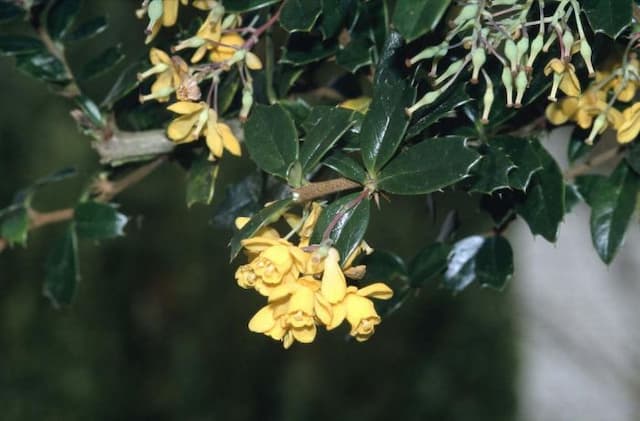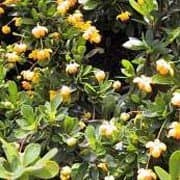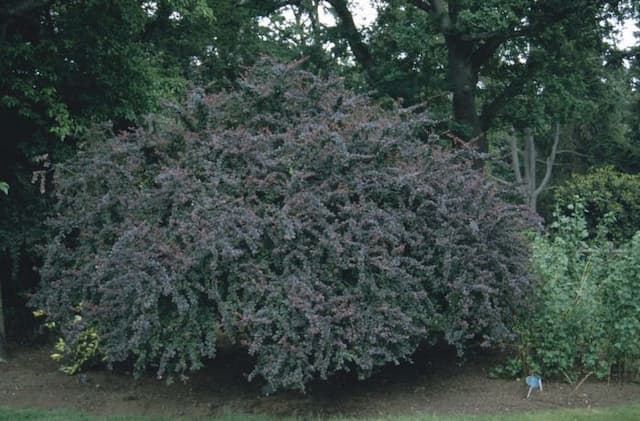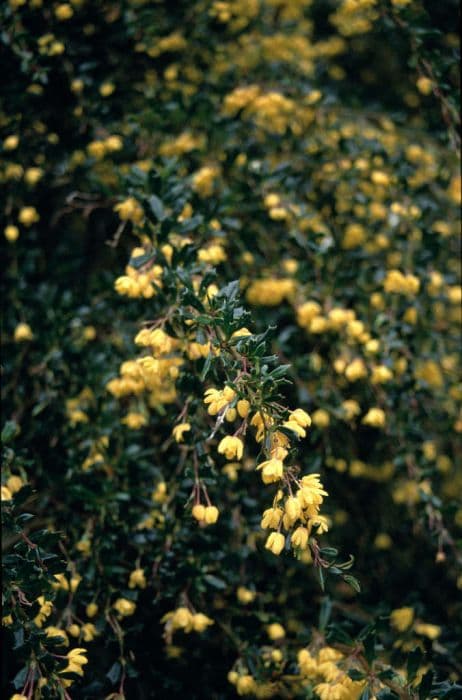Japanese Barberry Berberis thunbergii 'Orange Rocket' (PBR)

ABOUT
Berberis thunbergii 'Orange Rocket', commonly known as Japanese barberry 'Orange Rocket', is an ornamental shrub known for its vibrant foliage and compact growth habit. The leaves of the 'Orange Rocket' are small and spoon-shaped with a lively reddish-orange color in spring that transforms to a deep, ruby red as summer progresses. Come autumn, the foliage typically intensifies to brilliant shades of orange, red, or even purple, adding stunning color to the landscape. The plant displays a columnar form with upright branches, creating a vertical accent that works well in tight spaces or as a structured element in garden designs. The contrasting colors of the leaves make it a popular choice for adding visual interest. Additionally, this cultivar is known for its yellow flowers that appear in the spring, although they are often small and inconspicuous compared to the showy leaves. These blossoms may later give way to small, bright red berries that can attract birds and wildlife. The Japanese barberry 'Orange Rocket' is adorned with small, thorn-like spines along its branches, which can add a protective barrier when used in landscape settings. These spines also contribute to its distinctive appearance, giving the plant a slightly rugged yet visually appealing texture. The overall shape and coloration of the plant make it a versatile and attractive option for various garden styles, from formal to naturalistic designs.
About this plant
 Names
NamesFamily
Berberidaceae.
Synonyms
Orange Rocket Barberry, Japanese Barberry.
Common names
Berberis thunbergii 'Orange Rocket' (PBR)
 Toxicity
ToxicityTo humans
Japanese barberry, including the 'Orange Rocket' cultivar, is not generally regarded as highly toxic to humans. However, it may cause mild stomach upset if ingested. As with many plants, individuals may have varying sensitivities, and some people might experience more significant gastrointestinal discomfort, including nausea, vomiting, or diarrhea if they consume parts of this plant. Care should always be taken to avoid ingesting plants not known to be safe for consumption, and young children should be taught not to eat any parts of ornamental plants due to potential risks.
To pets
Japanese barberry, such as the 'Orange Rocket' cultivar, is considered to have a low level of toxicity to pets, but it can still be harmful if ingested. The symptoms of poisoning in pets can include vomiting, diarrhea, or lethargy. As with humans, pets may show different levels of sensitivity to the plant, and the presence of thorns can also lead to physical injury. Therefore, it's always advisable to prevent pets from chewing on or ingesting the plant to avoid any potential health issues.
 Characteristics
CharacteristicsLife cycle
Perennials
Foliage type
Deciduous
Color of leaves
Mixed
Flower color
Yellow
Height
4 feet (1.2 meters)
Spread
2 feet (0.6 meters)
Plant type
Shrub
Hardiness zones
5
Native area
Japan
Benefits
 General Benefits
General Benefits- Aesthetic Appeal: The 'Orange Rocket' Barberry adds a striking burst of color with its vibrant orange-red foliage, which matures to a rich ruby red in the summer, providing visual interest throughout multiple seasons.
- Compact Size: This cultivar is known for its small, upright growth habit, making it suitable for smaller gardens or limited spaces without overpowering the area.
- Low Maintenance: Barberry plants are often prized for their ruggedness and low maintenance requirements, including tolerance of poor soils and less need for water once established.
- Drought Tolerance: Once established, 'Orange Rocket' Barberry has good drought tolerance, making it suitable for xeriscaping or in regions with water scarcity.
- Deer Resistance: Its thorny stems make it less appealing to deer, reducing the likelihood of damage from browsing.
- Seasonal Interest: With foliage that changes color throughout the seasons and bright red berries in the fall, 'Orange Rocket' Barberry provides year-round interest.
- Privacy and Borders: Can be used effectively for hedges, borders, or privacy screens due to its dense growth habit.
- Erosion Control: As a hardy shrub with a fibrous root system, it can be planted on slopes to help prevent soil erosion.
- Wildlife Habitat: While the berries are not significantly beneficial to many wildlife species, the dense foliage provides shelter for birds and beneficial insects.
- Architectural Definition: The distinct columnar form provides strong vertical lines that can be used to give structure and definition to landscape designs.
 Medical Properties
Medical PropertiesThis plant is not used for medical purposes.
 Air-purifying Qualities
Air-purifying QualitiesThis plant is not specifically known for air purifying qualities.
 Other Uses
Other Uses- Photography: The 'Orange Rocket' Barberry can provide a striking background or subject for autumnal photography due to its vibrant foliage.
- Textile Dyeing: Historically, some species of barberry have been used to extract yellow dye, which could potentially be applied to this variety.
- Artistic Inspiration: Artists may use the vivid colors of the 'Orange Rocket' Barberry leaves as inspiration for paintings, drawings, or fabric designs.
- Festive Decorations: Branches of the 'Orange Rocket' Barberry, with their bright orange-red leaves, can be used in fall decorations, wreaths, and centerpieces.
- Bonsai: With its compact habit and vibrant colors, 'Orange Rocket' Barberry can be cultivated as a bonsai plant.
- Edging for Pathways: The shrub can serve as a colorful edge for garden pathways, maintaining a clear boundary with added aesthetic appeal.
- Wildlife Shelter: Thick plantings of 'Orange Rocket' Barberry can provide shelter for small wildlife, such as birds and beneficial insects.
- Culinary Presentation: Although not typically consumed, the leaves can be used as a decorative garnish for their color contrast in culinary presentations.
- Seasonal Craft Material: The branches and berries can be used as supplies in making seasonal crafts for fall-themed activities or projects.
- Nature Studies: This plant can be used in educational settings to study plant growth, seasonal change, and horticultural practices.
Interesting Facts
 Feng Shui
Feng ShuiThe Japanese barberry is not used in Feng Shui practice.
 Zodiac Sign Compitability
Zodiac Sign CompitabilityThe Japanese barberry is not used in astrology practice.
 Plant Symbolism
Plant Symbolism- Transformation: The 'Orange Rocket' Barberry, with its changing colors through the seasons, represents the ability to adapt and transform, reflecting the dynamic nature of life’s journey.
- Protection: Barberry bushes are known for their thorns, which historically have been associated with protection and setting boundaries against negative energies or intruders.
- Endurance: This plant is hardy and resilient, symbolizing the strength and endurance required to overcome challenges and persist through difficult situations.
- Vibrancy: The vivid orange-red foliage of 'Orange Rocket' stands out in any landscape, symbolizing energy, passion, and the vibrancy of living life to its fullest.
 Water
WaterFor the Japanese Barberry 'Orange Rocket', water the plant deeply once a week, providing about 1 inch of water which equates to roughly 0.623 gallons per square foot of soil area. During hot, dry periods, increase watering frequency to twice a week. Ensure the soil is well-draining to prevent waterlogging. Always check the top 2 to 3 inches of soil before watering; if it's dry to the touch, it's time to water. During winter, reduce watering as the plant's water requirements decrease.
 Light
LightThe Japanese Barberry 'Orange Rocket' thrives in full sun to partial shade. For best foliage color and overall health, position the plant where it will receive at least six hours of direct sunlight each day. Light shade is tolerable, especially in the hottest part of the day, but too much shade may result in less vibrant foliage colors and a decrease in plant vigor.
 Temperature
TemperatureJapanese Barberry 'Orange Rocket' is hardy and can withstand temperatures as low as -30°F and as high as 100°F. The ideal temperature range for this plant is between 60°F and 75°F during the growing season. It is well-suited for USDA hardiness zones 4 through 8, making it adaptable to a wide range of climate conditions.
 Pruning
PruningPrune the Japanese Barberry 'Orange Rocket' in late winter or early spring to maintain its shape and encourage new growth. Remove any dead, diseased, or damaged branches and thin out crowded areas to improve air circulation. Pruning can also be done after the plant flowers to shape it or control its size, but be cautious as the thorns can be sharp.
 Cleaning
CleaningAs needed
 Soil
SoilJapanese barberry 'Orange Rocket' prefers well-drained soil with a pH range of 6.0 to 7.5. A good soil mix consists of equal parts loam, peat moss, and sand to ensure proper drainage and aeration. Amend with organic compost to provide nutrients. Mulching helps to maintain moisture and improves soil structure over time.
 Repotting
RepottingJapanese barberry 'Orange Rocket' generally does not require frequent repotting and it is often grown directly in the ground. If potted, repot every 2 to 3 years to refresh the soil and to accommodate root growth. Repot in early spring before new growth begins.
 Humidity & Misting
Humidity & MistingJapanese barberry 'Orange Rocket' is adaptable to a wide range of humidity levels and does not require high humidity; average outdoor humidity is generally suitable. It is tolerant of dry to moderate humidity conditions but should be protected from excessively dry air, particularly in winter.
 Suitable locations
Suitable locationsIndoor
Position in bright light, avoid direct sun. Water moderately.
Outdoor
Plant in well-drained soil, full to partial sun.
Hardiness zone
4-8 USDA
 Life cycle
Life cycleThe Berberis thunbergii 'Orange Rocket', also known as Japanese Barberry 'Orange Rocket', begins its life as a seed, which after dispersing, typically requires a period of stratification to break dormancy. Upon germination, the seedling emerges and establishes roots, while its stem and leaves begin to develop. As the plant enters the juvenile stage, it focuses on vegetative growth, producing the characteristic orange to red foliage in spring, maturing to green, and then to vibrant red in the fall. Eventually, it reaches maturity, wherein it produces small, yellow flowers in the spring, followed by the development of bright red berries that are enjoyed by birds, aiding in seed dispersal. Given the right conditions, Japanese Barberry 'Orange Rocket' can live for several decades, repeatedly undergoing seasonal growth cycles while also tolerating pruning well, which can prolong its attractiveness and health. At the end of its life, the plant gradually declines in vigor, ceasing to produce new growth and eventually succumbing to environmental stresses or senescence.
 Propogation
PropogationPropogation time
Spring-Early Summer
The Japanese barberry 'Orange Rocket' is most commonly propagated by softwood cuttings. The best time to take cuttings is in late spring to early summer when new growth is still flexible. Cuttings should be about 4 to 6 inches (10 to 15 cm) long, taken from healthy stems with a sharp, clean pair of pruners. Remove the lower leaves to expose a few nodes where the root will form and dip the end of the cutting into a rooting hormone powder for best results. The treated cuttings should then be placed in a well-draining growing medium, such as a mix of peat and perlite, and kept at a consistent humidity and warmth, ideally under a misting system or plastic tent, to encourage rooting. Roots typically establish after a few weeks, after which the new plants can be gradually acclimated to normal growing conditions before transplanting.









